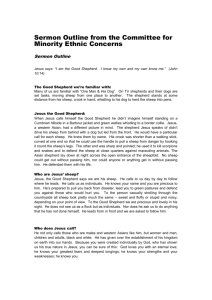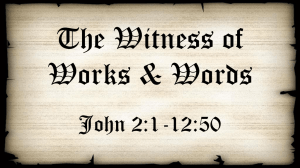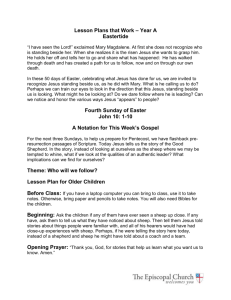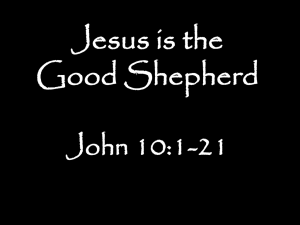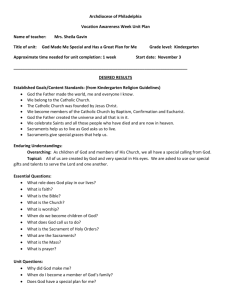Art Print - Loyola Press
advertisement
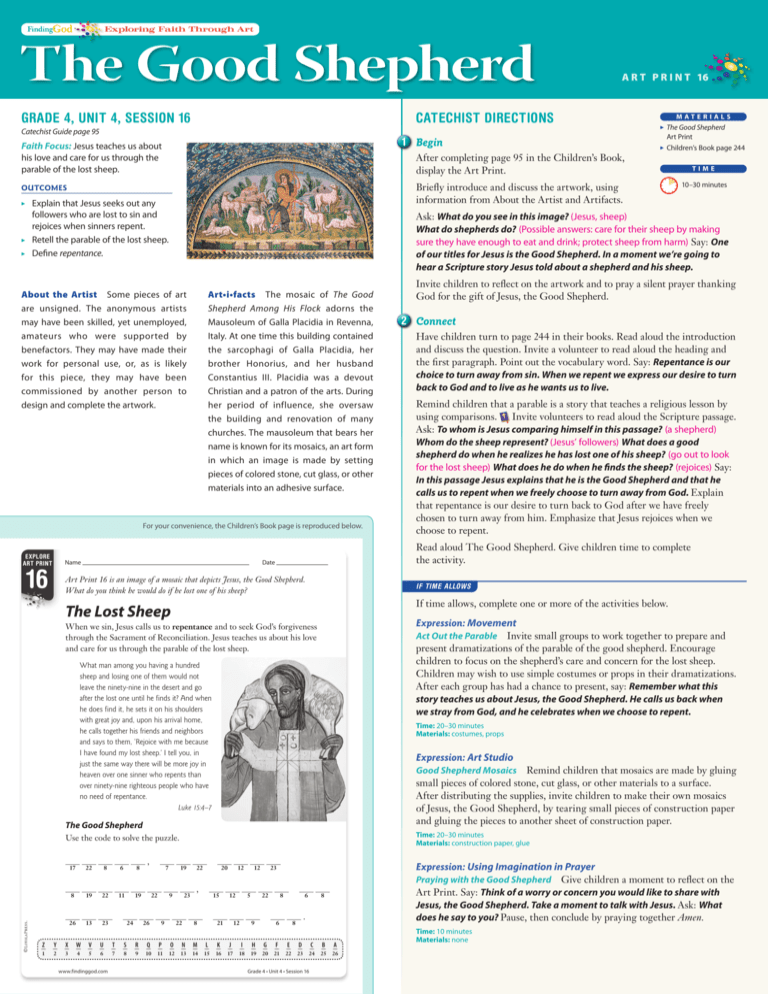
The Good Shepherd GRADE 4, UNIT 4, SESSION 16 CATECHIST DIRECTIONS Catechist Guide page 95 1 Begin Faith Focus: Jesus teaches us about his love and care for us through the parable of the lost sheep. After completing page 95 in the Children’s Book, display the Art Print. Explain that Jesus seeks out any followers who are lost to sin and rejoices when sinners repent. Retell the parable of the lost sheep. Define repentance. ▶▶ ▶▶ Art•i•facts The mosaic of The Good Shepherd Among His Flock adorns the Mausoleum of Galla Placidia in Revenna, Italy. At one time this building contained the sarcophagi of Galla Placidia, her brother Honorius, and her husband Constantius III. Placidia was a devout Christian and a patron of the arts. During her period of influence, she oversaw the building and renovation of many churches. The mausoleum that bears her name is known for its mosaics, an art form in which an image is made by setting pieces of colored stone, cut glass, or other materials into an adhesive surface. For your convenience, the Children’s Book page is reproduced below. Name 16 Date © 8 19 22 26 13 23 11 19 24 7 22 26 Have children turn to page 244 in their books. Read aloud the introduction and discuss the question. Invite a volunteer to read aloud the heading and the first paragraph. Point out the vocabulary word. Say: Repentance is our choice to turn away from sin. When we repent we express our desire to turn back to God and to live as he wants us to live. Remind children that a parable is a story that teaches a religious lesson by using comparisons. Invite volunteers to read aloud the Scripture passage. Ask: To whom is Jesus comparing himself in this passage? (a shepherd) Whom do the sheep represent? (Jesus’ followers) What does a good shepherd do when he realizes he has lost one of his sheep? (go out to look for the lost sheep) What does he do when he finds the sheep? (rejoices) Say: In this passage Jesus explains that he is the Good Shepherd and that he calls us to repent when we freely choose to turn away from God. Explain that repentance is our desire to turn back to God after we have freely chosen to turn away from him. Emphasize that Jesus rejoices when we choose to repent. Expression: Art Studio Good Shepherd Mosaics Remind children that mosaics are made by gluing small pieces of colored stone, cut glass, or other materials to a surface. After distributing the supplies, invite children to make their own mosaics of Jesus, the Good Shepherd, by tearing small pieces of construction paper and gluing the pieces to another sheet of construction paper. 9 23 22 22 20 , 15 8 12 12 21 12 5 12 Expression: Using Imagination in Prayer 23 22 9 8 6 6 Praying with the Good Shepherd Give children a moment to reflect on the Art Print. Say: Think of a worry or concern you would like to share with Jesus, the Good Shepherd. Take a moment to talk with Jesus. Ask: What does he say to you? Pause, then conclude by praying together Amen. 8 . 8 Z Y X W V U T S R Q P O N M L K J I H G F E D C B A 1 2 3 4 5 6 7 8 9 10 11 12 13 14 15 16 17 18 19 20 21 22 23 24 25 26 www.findinggod.com 2 Connect Time: 20–30 minutes Materials: construction paper, glue 19 9 Invite children to reflect on the artwork and to pray a silent prayer thanking God for the gift of Jesus, the Good Shepherd. Time: 20–30 minutes Materials: costumes, props Use the code to solve the puzzle. , 10–30 minutes Act Out the Parable Invite small groups to work together to prepare and present dramatizations of the parable of the good shepherd. Encourage children to focus on the shepherd’s care and concern for the lost sheep. Children may wish to use simple costumes or props in their dramatizations. After each group has had a chance to present, say: Remember what this story teaches us about Jesus, the Good Shepherd. He calls us back when we stray from God, and he celebrates when we choose to repent. The Good Shepherd 8 TIME Expression: Movement What man among you having a hundred sheep and losing one of them would not leave the ninety-nine in the desert and go after the lost one until he finds it? And when he does find it, he sets it on his shoulders with great joy and, upon his arrival home, he calls together his friends and neighbors and says to them, ‘Rejoice with me because I have found my lost sheep.’ I tell you, in just the same way there will be more joy in heaven over one sinner who repents than over ninety-nine righteous people who have no need of repentance. Luke 15:4–7 6 Book page 244 If time allows, complete one or more of the activities below. When we sin, Jesus calls us to repentance and to seek God’s forgiveness through the Sacrament of Reconciliation. Jesus teaches us about his love and care for us through the parable of the lost sheep. 8 ▶▶ Children’s IF TIME ALLOWS The Lost Sheep 22 Art Print Read aloud The Good Shepherd. Give children time to complete the activity. Art Print 16 is an image of a mosaic that depicts Jesus, the Good Shepherd. What do you think he would do if he lost one of his sheep? 17 ▶▶ The Good Shepherd Ask: What do you see in this image? (Jesus, sheep) What do shepherds do? (Possible answers: care for their sheep by making sure they have enough to eat and drink; protect sheep from harm) Say: One of our titles for Jesus is the Good Shepherd. In a moment we’re going to hear a Scripture story Jesus told about a shepherd and his sheep. About the Artist Some pieces of art are unsigned. The anonymous artists may have been skilled, yet unemployed, amateurs who were supported by benefactors. They may have made their work for personal use, or, as is likely for this piece, they may have been commissioned by another person to design and complete the artwork. EXPLORE ART PRINT MATERIALS Briefly introduce and discuss the artwork, using information from About the Artist and Artifacts. OUTCOMES ▶▶ A R T P R I N T 16 Grade 4 • Unit 4 • Session 16 Time: 10 minutes Materials: none The Good Shepherd Anonymous, fifth century. AR T PR I NT 16
